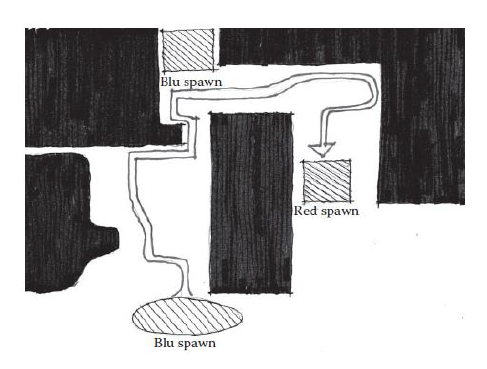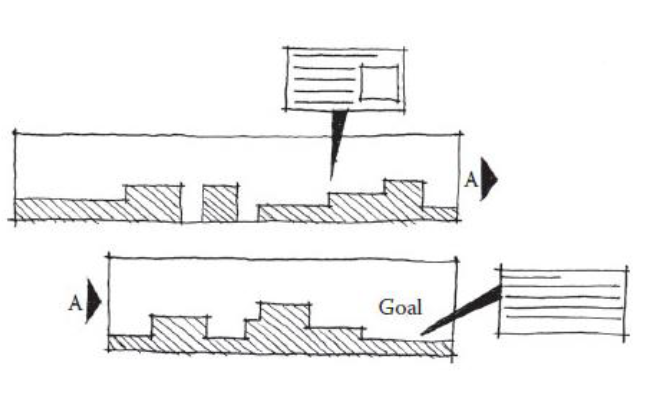Nintendo Power Method
Classification
#method
- #medium/visual
- #tools/non-digital or #tools/digital
Intent
- To manage the pacing of your level on a macro-level.
Problem
- Similar to the pacing diagram method as it deals with creating an engaging level with essential story points.
- It is important to revise your level with focus on the essential story points, what seems important to the players.
- How do you analyze the flow of your level?
- You need to understand the level from the perspective of the player.
Solution Approach
- The Nintendo Power method originated in the late 1980s in the game strategy and news magazine “Nintendo Power” (Totten 2019 - An Architectural Approach of Level Design, p. 82-84).
- This method involves publishing maps of levels with important gameplay points marked as caption balloons (Totten 2019 - An Architectural Approach of Level Design, p. 82-84).
- Designed as an overview to highlight critical gameplay points.
- It is valuable for game designers and developers, as it facilitates the analysis of player importance.
Application
Input
- Game beats.
- Map of your level.
Application
- Combine the gameplay beats and mark them on the map.
- Analyze if the gameplay points create excessive density or restrict player breathing space.
- If the points densely populate the area, consider reducing them to allow more breathing room for the player.
Output
- A Map with beats marked in your level.
- Spatial layout of your level.
When to Use It
- Analyze the density of your level and assess what’s crucial for the player.
- Add or remove story points to adjust pacing.
Relevant Roles Using This Method
- #roles/designer Designer #used-by/designer
- #roles/engineers Engineer #used-by/engineers
- #roles/player Player
Relevancy in the Following Processes
- Similar to the pacing graph method.
- Game Development designing step, after you already have a map.
- Gamespace Prototyping to evaluate your created map
- Evaluate your Combat Design
- Part of the Iterative Map Design
- Potentially useful in playtesting and post-development iterations to improve the level based on player feedback.
Applicability
- Suitable for managing spatial layout, rather than focusing on timelines.
- Not suitable for pacing time events; use a linear Pacing Diagram for that purpose.
Pros and Cons
Pros:
- Helps establish spatial relations.
- Allows analysis of player preferences and importance.
- Identifies densely packed areas.
- Facilitates the inclusion of safe spaces for exploration.
- Reveals player shortcuts and loopholes.
Cons:
- Lacks timing relations.
- A 2D map does not represent vertical spacing.
- Considering metrics can complicate and confuse a map.
- Uncertainty about when to use it; in design, after implementation, or during implementation? Decisions regarding the map’s design status must be clarified.
Relation with Other Methods
- Similar to a Pacing Diagram, but with a focus on spatial relations.
- Drawing a Map
- Evaluates Pillars, Goals and Features regarding their significance in the level (are the goals of the level met?)
- Critical Path Analysis is similar to the Nintendo Power Method, as it evaluates the players actual spatial movements
-
Behavior Diagram explains the player’s and NPC behavior and can be influenced by the Nintendo Power method
Examples
-
2D top-down with spawns and walls and paths marked
 _(Source: Totten 2019 - An Architectural Approach of Level Design, p. 82-84)
_(Source: Totten 2019 - An Architectural Approach of Level Design, p. 82-84) - 2D frontal view of Mario level with the varying ground levels and bubbles to mark gameplay beats
 (Source: Nintendo Power Method, p.82-84)
(Source: Nintendo Power Method, p.82-84)
Relevant Tools
- Digital Art Tools
- Non-digital Design Tools, Pen and Paper
- Digital Collection Tools
- Communication Tools
Literature
Totten 2019 - An Architectural Approach of Level Design
...
Notes mentioning this note
Behavior Diagram
also known as: Behavioral Diagram, Dynamic View, Activity Diagram, Use Case Diagram, State Machine Diagram, …?